MIST
Magnetosphere, Ionosphere and Solar-Terrestrial
Nuggets of MIST science, summarising recent papers from the UK MIST community in a bitesize format.
If you would like to submit a nugget, please fill in the following form: https://forms.gle/Pn3mL73kHLn4VEZ66 and we will arrange a slot for you in the schedule. Nuggets should be 100–300 words long and include a figure/animation. Please get in touch!
If you have any issues with the form, please contact This email address is being protected from spambots. You need JavaScript enabled to view it..
Cassini’s Grand Finale:- Planetary Period Oscillations are everywhere and the dayside field ‘lags’
by Gabby Provan (University of Leicester)
Saturn’s Planetary Period Oscillations are oscillations at close to Saturn’s planetary period which have been observed to organize all of Saturn’s ionospheric and magnetospheric parameters throughout the Cassini mission. There are two oscillatory systems, one in the Northern hemisphere and one in the Southern. The enduring mystery is that so far we have yet to understand how a perfectly axisymmetric planetary magnetic field can create such oscillations
In this paper, we study the magnetic field throughout the Cassini Grand Finale orbits. On these orbits Cassini passed from the northern auroral region in the dawn sector, through the gap between the D ring inner edge and Saturn’s atmosphere, and outbound to the southern auroral region in the dusk sector (See Figure 1). We observe dual PPO modulations on auroral, subauroral, ring-region and intra-ring region field lines – in other words everywhere (see Figure 2). This is the first time that PPOs have been observed on and inside ring region field lines. The presence of such field perturbations may provide an explanation for apparent PPO-related phenomena observed in the ring material itself, through the action of these fields on charged dust grains (see e.g. Chancia et al., 2019).
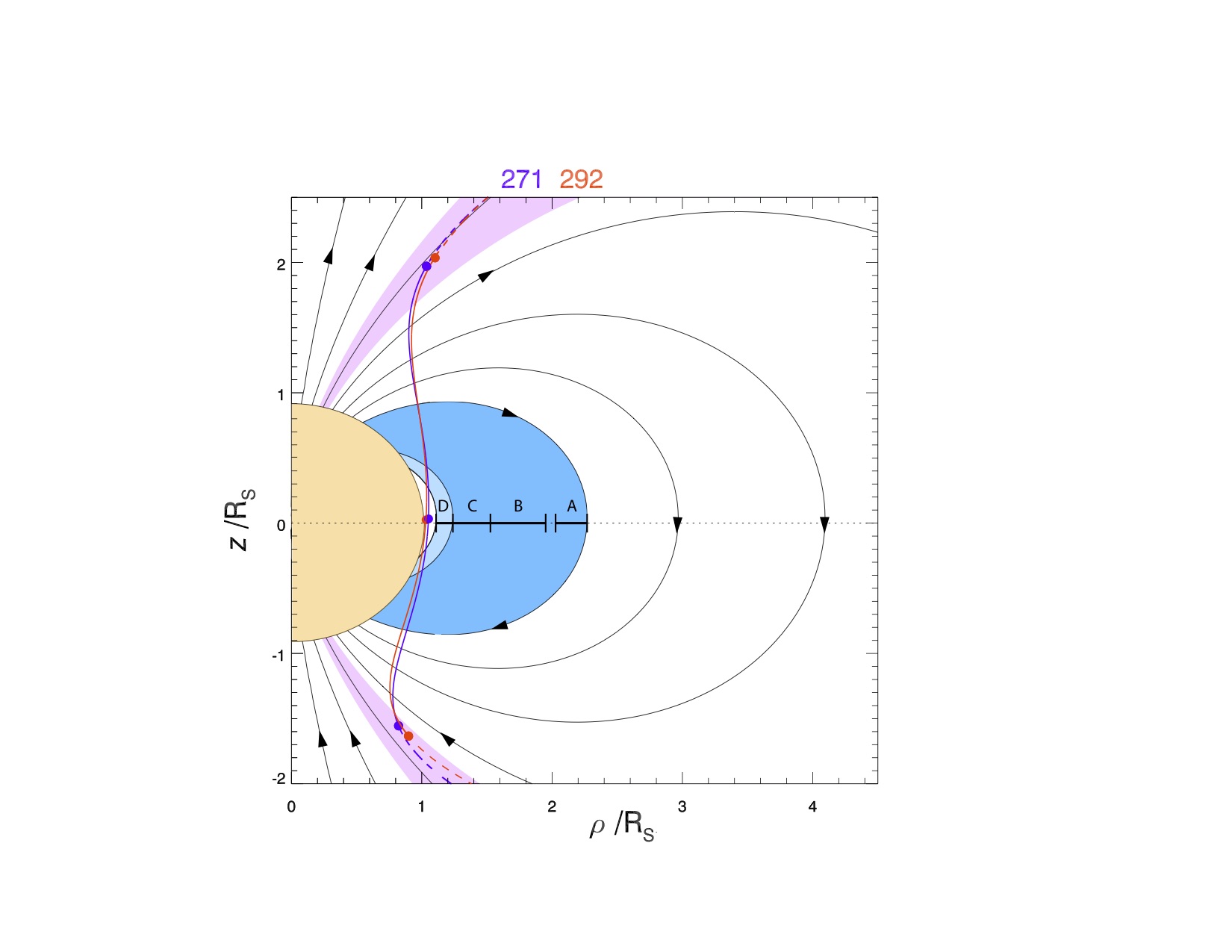
Figure 1: Plot of the periapsis pass trajectories of the initial and final proximal orbits, Revs 271 (blue) and 292 (red), projected into a meridian plane in cylindrical coordinates. The darker blue field-aligned area corresponds to field lines mapping through the main ring region in the equatorial plane, between the inner boundary of the C ring and the outer boundary of the A ring, while the lighter blue field-aligned area corresponds to field lines mapping through the D ring.
Next, we considered the residual magnetic field, having discounted the magnetic signature of the PPOs and Saturn’s ring current from the observed magnetic field observations. We found that the residual azimuthal field had a lagging configuration in the subauroral region with a magnitude ~3-5 nT. These fields extend essentially unmodified inwards, crossing the ring region and the field lines mapping to Saturn synchronous orbit, to the outer boundary of D ring field lines. The lagging field indicates a field-aligned current flow of ~0.25 MA rad-1 flowing from the southern ionosphere toward the C and inner B rings. The physical origin of the extended region of lagging dayside fields remains unclear.
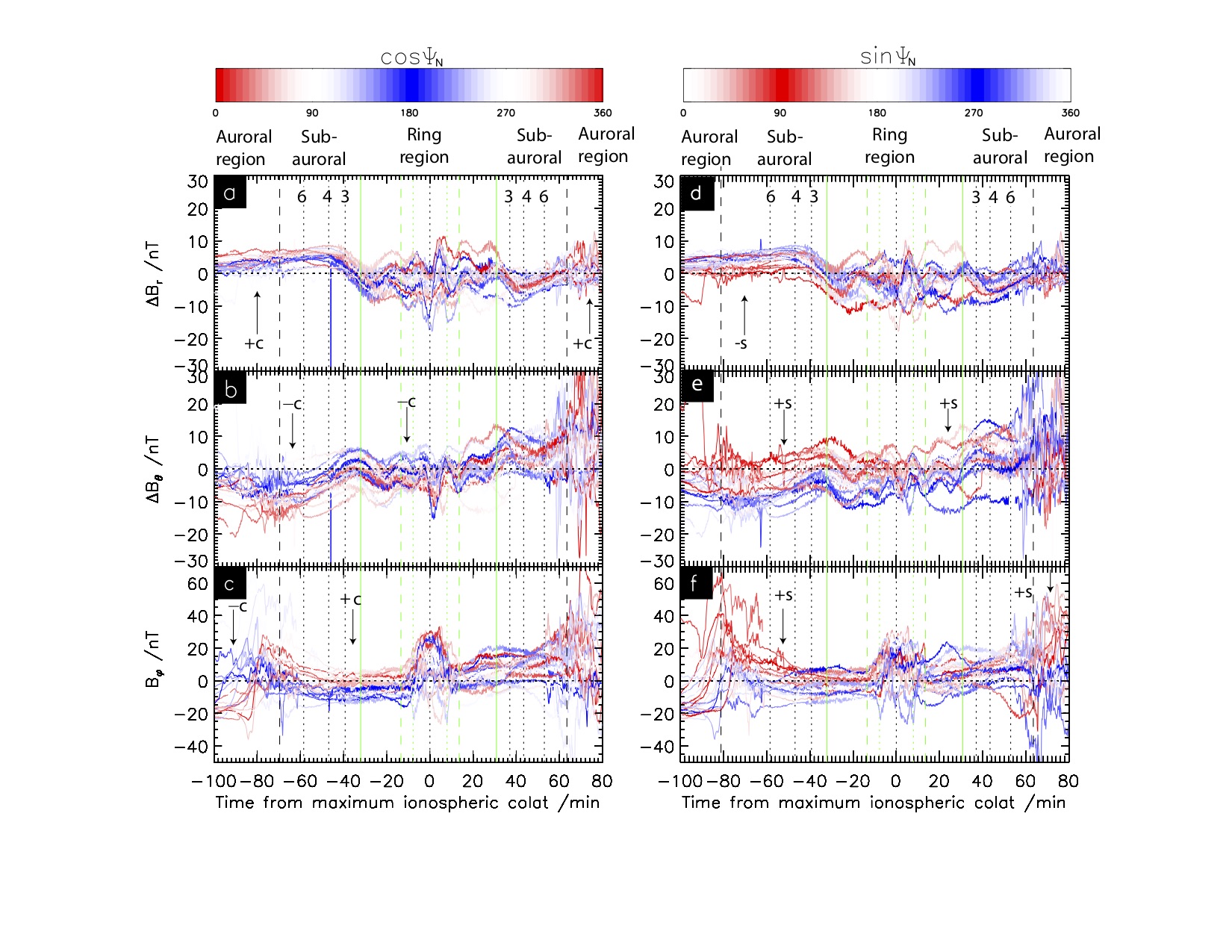
Figure 2: Field data from all the proximal orbit periapsis passes, color-coded according the northern PPO system phase. The data are plotted versus time from their field-parallel points taken as t = 0 (central vertical black dotted line), over the interval between -100 and +80 min, Vertical dashed lines indicate the equatorward boundary of the auroral region. The green solid lines mark the field line passing through the outer boundary of the A ring, while the green dashed and dotted lines mark the field lines passing through the outer and inner boundaries of the D ring, respectively. Data in Figures 2a-2c on the left are color-coded by northern PPO phase such that phases near 0°-360° are colored red and phases near 180° blue. Similarly, data in Figures 2d-2f on the right are color-coded by northern PPO phase such that phases near 90° are colored red and phases near 270° blue.
For more information, please see the paper:
Provan, G., Cowley, S. W. H., Bradley, T. J., Bunce, E. J., Hunt, G. J., Cao, H., & Dougherty, M. K. ( 2019). Magnetic field observations on Cassini's proximal periapsis passes: Planetary period oscillations and mean residual fields. Journal of Geophysical Research: Space Physics, 124. https://doi.org/10.1029/2019JA026800
Effects of VLF transmitter waves on the inner belt and slot region
by Johnathan Ross (British Antarctic Survey)
Signals from man made VLF (Very Low Frequency) transmitters can leak from the Earth-ionosphere wave guide into the inner magnetosphere, where they propagate as electromagnetic waves and contribute to electron dynamics in the inner radiation belt and slot region. These waves are highly localised around the transmitters and are strongest on the nightside. It has been suggested that these waves may be responsible for removing the hazardous MeV energy electrons from this region that can be extremely damaging to satellites. The VLF transmitter waves scatter electrons in pitch angle (the angle between the background field and electron velocity). In an average sense, this scattering can be represented by a diffusion equation, with a diffusion coefficient that can be calculated using quasi-linear theory. In this study we use ~5 years of Van Allen Probesobservations to construct global statistical models of the diffusion coefficients for each individual VLF transmitter, as a function of L*, Magnetic Local Time (MLT) and geographic longitude.
These diffusion coefficients are then incorporated into a 1D pitch-angle diffusion model with longitude and MLT dependence. We find that global averages of the wave power capture the long-term dynamics of the loss process, despite the highly localised nature of the waves in space. We use our model to assess the role of VLF transmitter waves compared to other important loss processes (hiss waves and coulomb collisions) on electron loss in the inner radiation belt and slot region. The figure shows the decay timescales as a function of L value for different combinations of the VLF transmitter (T), coulomb collisions (C), and hiss wave (H) processes. At moderate relativistic energies, E~500 keV (panel d), waves from VLF transmitters have a significant role! They reduce electron lifetimes by an order of magnitude or more, down to the order of 200 days near the outer edge of the inner radiation belt. However, VLF transmitter waves are ineffective at removing multi-MeV electrons (panel f) from either the inner radiation belt or slot region. The results suggest that although the VLF transmitters are important for radiation belt loss, they cannot be responsible for removing the dangerously high energy electrons from the region occupied by satellites.
For more information, please see the paper:
Ross, J. P. J., Meredith, N. P., Glauert, S. A., Horne, R. B., & Clilverd, M. A. ( 2019). Effects of VLF transmitter waves on the inner belt and slot region. Journal of Geophysical Research: Space Physics, 124, 5260– 5277. https://doi.org/10.1029/2019JA026716
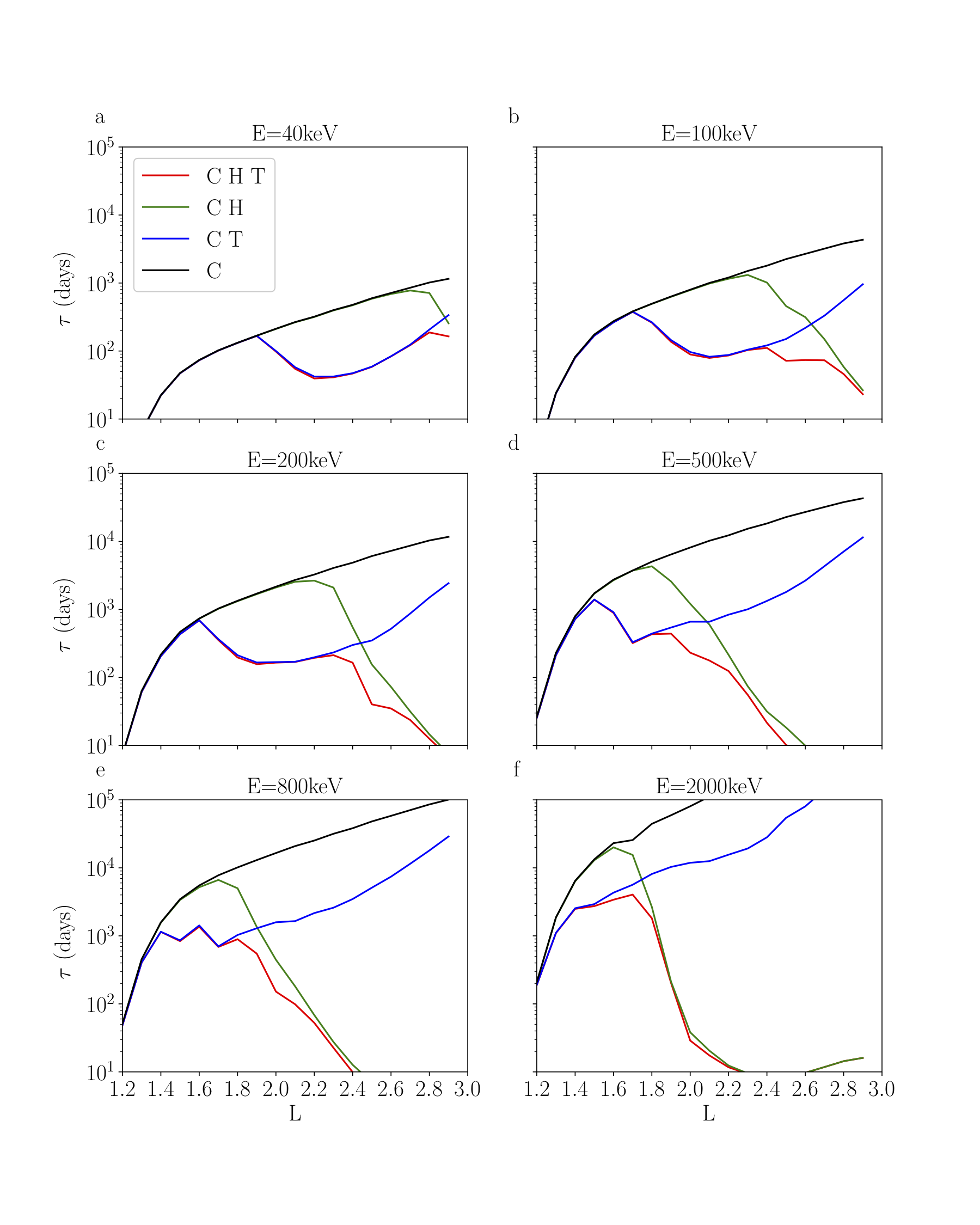
Figure: Electron decay timescales from the 1D model with MLT and longitude averaging. The lines correspond to: black - Coulomb collisions; green - hiss and Coulomb collisions; blue - VLF transmitters and Coulomb collisions; red - VLF transmitters, hiss and Coulomb collisions.
How does substorm activity affect the ring current?
by Jasmine Kaur Sandhu (MSSL, UCL)
Earth’s magnetosphere is highly dynamic and due to coupling with the solar wind huge amounts of energy can be stored in the stretched magnetotail. Substorms (impulsive bursts of nightside reconnection) rapidly close large amounts of the tail flux and, through enhanced convection and injection of plasma, substorms can significantly energise the ring current population.
Do substorms with different properties affect the ring current differently?
Substorms can occur as an isolated event (preceded and followed by quiet periods) or as part of a compound event (multiple substorms occurring one directly after the other). A statistical analysis of ion observations from the Van Allen Probes was conducted to identify the similarities and differences in the ring current population during isolated substorms and the first compound substorm in a sequence. Figure a,b,d,e shows L-MLT maps of the median ring current energy content for both isolated and compound substorms, as well as before substorm onset (growth phase) and after substorm onset (expansion phase). Figure c,f shows statistically significant changes following onset and Figure g,h shows the difference in energy content for compound substorms compared to isolated.
Both types of substorms are associated with an enhancement post-onset, where the total enhancement is larger for a compound substorm. We also observed that the ring current energy content is elevated during compound substorms compared to isolated substorms, both before and after onset. Analysis shows that a key driver of these differences is the enhanced and prolonged solar wind driving prior to onset of compound substorms. Plasma is more effectively circulated to the inner magnetosphere and the density of injections are increased.
Overall the work demonstrates the importance of solar wind driving for the substorm – ring current relationship and suggests that compound substorms are able to very effectively energise the ring current to a high degree.
For more information, please see the paper:
Sandhu, J. K., Rae, I. J., Freeman, M. P., Gkioulidou, M., Forsyth, C., Reeves, G. D., et al. (2019). Substorm‐ring current coupling: A comparison of isolated and compound substorms. Journal of Geophysical Research: Space Physics, 124. https://doi.org/10.1029/2019JA026766
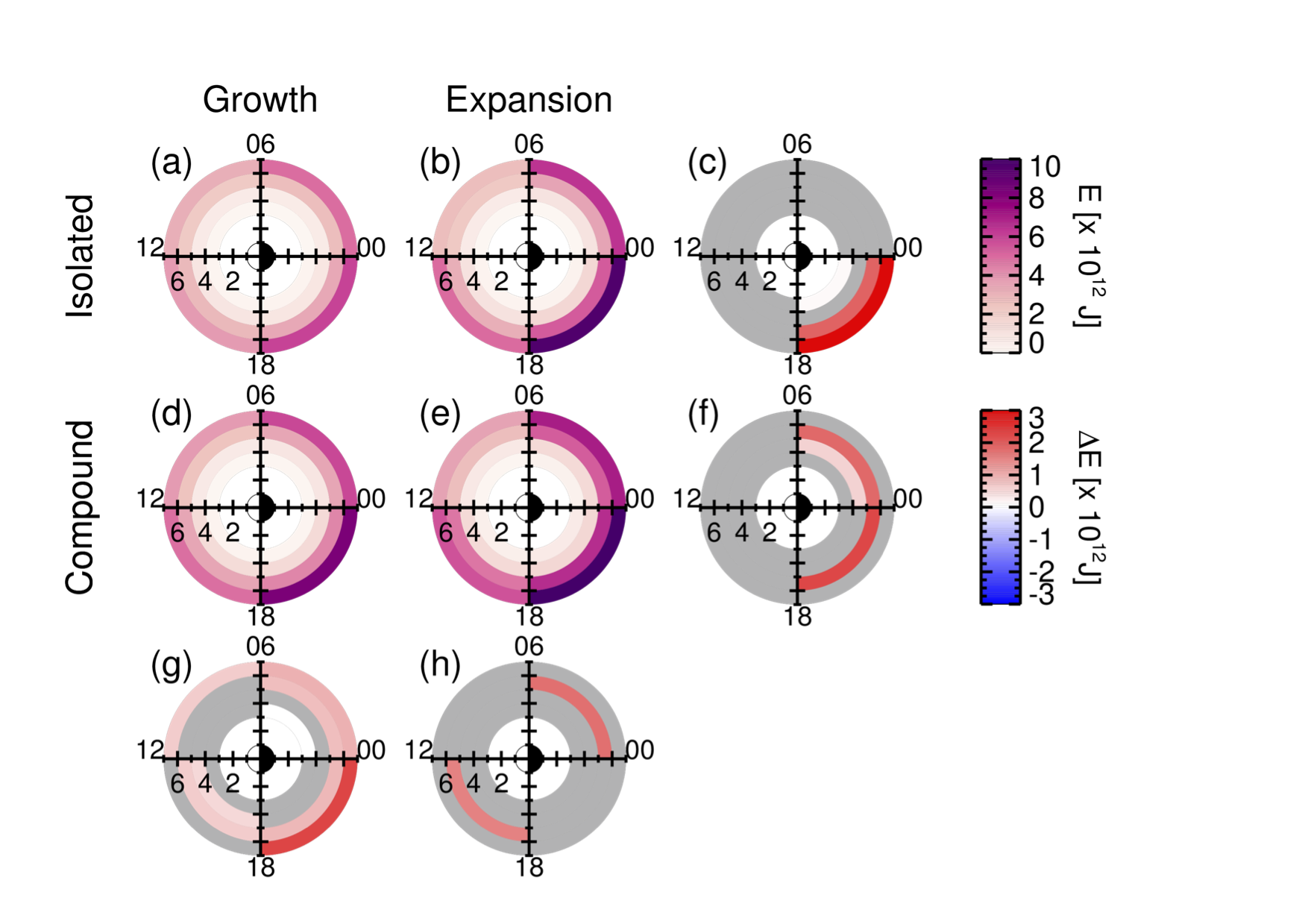
Figure: Values for each L‐MLT bin are plotted at the bins' location in the L‐MLT domain for the H+ ions. The mean energy values, E (J), are shown for (a) growth phases of isolated substorms, (b) expansion phases of isolated substorms, (d) growth phases of compound substorms, and (e) expansion phases of isolated substorms. The difference in the mean values, ΔE (J), for the expansion phase relative to the growth phase is shown for (c) isolated substorms and (f) compound substorms. The difference in mean values for the compound substorms relative to the isolated substorms is shown for (g) the growth phase and (h) the expansion phase. It is noted that, for the difference plots (c, f, g, h), the difference in mean values is only plotted if the distributions are identified to be statistically different according to the Kolmogorov‐Smirnov test with p<0.01. MLT = magnetic local time.
First evidence for multiple-harmonic standing Alfvén waves in Jupiter’s equatorial plasma sheet
By Harry Manners (Imperial College London)
Ultra-low-frequency (ULF) magnetohydrodynamic waves carry energy and momentum through planetary magnetospheres, corresponding to perturbations on large spatial-scales. These perturbations can lead to global oscillations of the magnetic field known as field line resonances (FLRs). While ULF waves and FLRs have been studied extensively in the terrestrial magnetosphere, relatively little literature exists concerning the same phenomena in magnetospheres of the outer planets.
We have used magnetometer data from the Galileo spacecraft to search for ULF wave-power at Jupiter, specifically in the thin, dense equatorial plasma sheet (see panel a of Figure). By removing the background magnetic field we were able to isolate perturbations in the direction transverse to the background field (panel b). We obtained frequency-time information via wavelet transforms of the magnetic-field residuals.
We found evidence for a multiple-harmonic wave structure isolated in the equatorial plasma sheet, on 8th November 1996. Four harmonics were detected, with periods ranging from 4 to 22 minutes (panel c).
We band-pass filtered the transverse field components to obtain a ~1 nT contribution from each harmonic. Subsequent polarization analysis revealed reversals in handedness in each signal consistent with the structure of a multiple-harmonic standing Alfvén wave (panel d). The same analysis suggests all of the detected harmonics are odd modes, with no evidence to support the presence of even modes. We currently have no explanation for the absence of the even modes, but speculate that it is a consequence of the symmetry of the driving mechanism with respect to the magnetic equator.
For more information, please see the paper:
Manners, H. A., & Masters, A. (2019). First evidence for multiple‐harmonic standing Alfvén waves in Jupiter's equatorial plasma sheet. Geophysical Research Letters, 46. https://doi.org/10.1029/2019GL083899
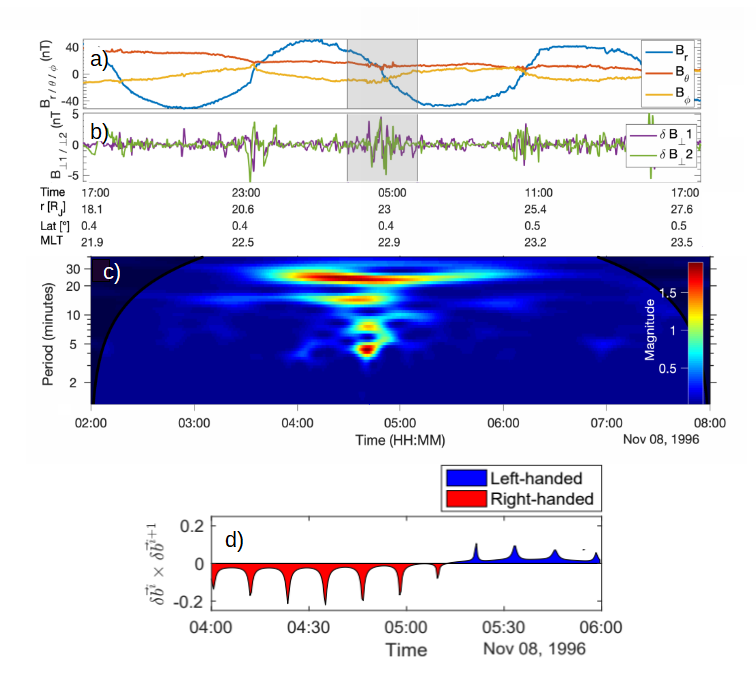
Figure: a) Magnetic field data from the Galileo spacecraft during 8th November 1996. b) Transverse magnetic field residuals, showing ULF wave packets. c) Wavelet transform of one of the transverse components, showing coincident enhancements in wave power at 22, 14, 7 and 4 minutes. d) Reversals in the handedness of the 22 minute wave signal, consistent with standing Alfvén waves.
Timescales of Birkeland Currents Driven by the IMF
By John Coxon (University of Southampton)
Birkeland currents are the mechanism by which information is communicated from Earth’s magnetopause to the ionosphere. Understanding the timescales of these currents is very useful for understanding the ionosphere’s reaction to magnetopause phenomena. We use the Active Magnetosphere and Planetary Electrodynamics Response Experiment (AMPERE) dataset, which uses magnetometers on 66 spacecraft in low Earth orbit to derive Birkeland current density on a grid of colatitude and magnetic local time. The current densities are derived in a ten minute sliding window, evaluated every two minutes.
We use the SPatial Information from Distributed Exogenous Regression (SPIDER) technique (Shore et al, 2019), which treats each coordinate of a global dataset (e.g. AMPERE or SuperMAG) independently, regressing the time series in each coordinate against some external driver to find the time lag that maximises the correlation of the two.
The figure below shows the correlation (left) and lag (centre) of the current densities with Interplanetary Magnetic Field (IMF) Bz. We focus on the R1 and R2 regions (right) here. Southward (negative) Bz drives Birkeland current as a result of magnetic reconnection, as shown by the correlations. Looking at the lags on the dayside, the poleward lags are 10–20 minutes, reflecting the time taken for the Birkeland currents to start to react to magnetic reconnection. At all MLT, the equatorward lags are 60–90 minutes, reflecting the time at which the polar cap is largest. On the nightside, the poleward lags are 90–150 minutes, reflecting how long it takes the polar cap to contract during nightside reconnection. More details on the R1/R2 correlations, and other correlations between Birkeland current and IMF Bz and By, are available in the full study.
For more information, please see the paper:
, , , , , , et al. ( 2019). Timescales of Birkeland currents driven by the IMF. Geophysical Research Letters, 46, 7893– 7901. https://doi.org/10.1029/2018GL081658

Figure: Correlation (left) and lag (centre) of AMPERE current density with IMF Bz in March 2010. A key to the regions visible is presented in the right-hand panel, to allow easy references in the text above.